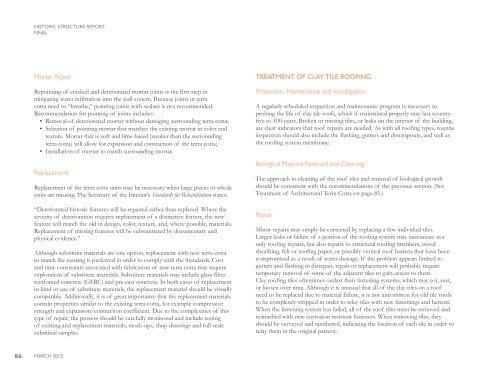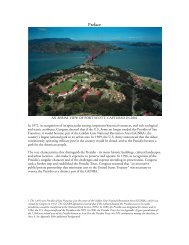Presidio Chapel Historic Structure Report - Presidio Trust
Presidio Chapel Historic Structure Report - Presidio Trust
Presidio Chapel Historic Structure Report - Presidio Trust
- No tags were found...
You also want an ePaper? Increase the reach of your titles
YUMPU automatically turns print PDFs into web optimized ePapers that Google loves.
HISTORIC STRUCTURE REPORTFINALMortar RepairRepointing of cracked and deteriorated mortar joints is the first step inmitigating water infiltration into the wall system. Because joints in terracotta need to “breathe,” pointing joints with sealant is not recommended.Recommendation for pointing of joints includes:• Removal of deteriorated mortar without damaging surrounding terra cotta;• Selection of pointing mortar that matches the existing mortar in color andtexture. Mortar that is soft and lime-based (weaker than the surroundingterra cotta) will allow for expansion and contraction of the terra cotta;• Installation of mortar to match surrounding mortar.ReplacementReplacement of the terra cotta units may be necessary when large pieces or wholeunits are missing. The Secretary of the Interior’s Standards for Rehabilitation states:“Deteriorated historic features will be repaired rather than replaced. Where theseverity of deterioration requires replacement of a distinctive feature, the newfeature will match the old in design, color, texture, and, where possible, materials.Replacement of missing features will be substantiated by documentary andphysical evidence.”Although substitute materials are one option, replacement with new terra cottato match the existing is preferred in order to comply with the Standards. Costand time constraints associated with fabrication of new terra cotta may requireexploration of substitute materials. Substitute materials may include glass fiberreinforced concrete (GFRC) and pre-cast concrete. In both cases of replacementin-kind or use of substitute materials, the replacement material should be visuallycompatible. Additionally, it is of great importance that the replacement materialscontain properties similar to the existing terra cotta, for example compressivestrength and expansion/contraction coefficient. Due to the complexities of thistype of repair, the process should be carefully monitored and include testingof existing and replacement materials, mock-ups, shop drawings and full scalesubmittal samples.TREATMENT OF CLAY TILE ROOFINGProtection, Maintenance and InvestigationA regularly scheduled inspection and maintenance program is necessary toprolong the life of clay tile roofs, which if maintained properly may last seventyfiveto 100-years. Broken or missing tiles, or leaks on the interior of the building,are clear indicators that roof repairs are needed. As with all roofing types, routineinspection should also include the flashing, gutters and downspouts, and well asthe roofing system membrane.Biological Material Removal and CleaningThe approach to cleaning of the roof tiles and removal of biological growthshould be consistent with the recommendations of the previous section. (SeeTreatment of Architectural Terra Cotta on page 85.)RepairMinor repairs may simply be corrected by replacing a few individual tiles.Larger leaks or failure of a portion of the roofing system may necessitate notonly roofing repairs, but also repairs to structural roofing members, woodsheathing, felt or roofing paper, or possibly vertical roof battens that have beencompromised as a result of water damage. If the problem appears limited togutters and flashing in disrepair, repair or replacement will probably requiretemporary removal of some of the adjacent tiles to gain access to them.Clay roofing tiles oftentimes outlast their fastening systems, which may rot, rust,or loosen over time. Although it is unusual that all of the clay tiles on a roofneed to be replaced due to material failure, it is not uncommon for old tile roofsto be completely stripped in order to relay tiles with new fastenings and battens.When the fastening system has failed, all of the roof tiles must be removed andreattached with new corrosion resistant fasteners. When removing tiles, theyshould be surveyed and numbered, indicating the location of each tile in order torelay them in the original pattern.86MARCH 2012















